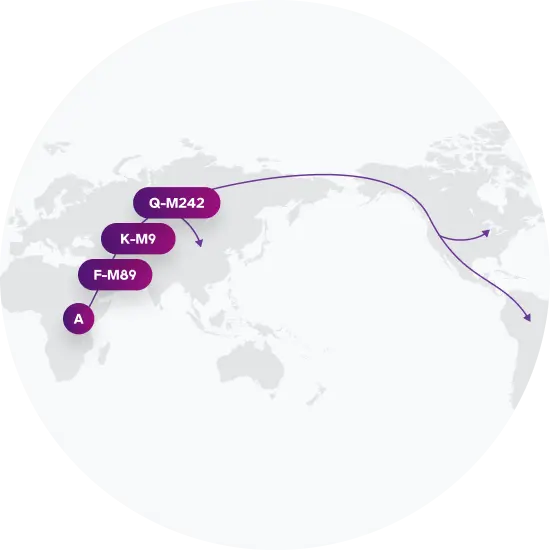Haplogroup Q-L663
What is Paternal Haplogroup Q-L663?
Haplogroup Q-L663, also known as Haplogroup Q-M242 (Y Chromosome Consortium long-form label), is a genealogical group of lineages defined by unique genetic markers present on the Y-chromosome. Your paternal haplogroup, or that of your father if you do not have a Y-chromosome, paints a picture of your ancient origins and the migrations of your ancestors. Although your paternal haplogroup reflects just one of your many ancestral lineages, it carries information about that lineage over tens of thousands of years.
Haplogroup Q-L663 is descended from haplogroup Q-M242. Among 23andMe research participants, haplogroup Q-L663 is commonly found among populations in Mexico.
It's important to note that your haplogroup doesn't define your current ethnic identity; rather, it provides an insight into your deep ancestry on the paternal side.
 Paternal Haplogroup Origins Q-M242
Paternal Haplogroup Origins Q-M242Top Surnames with Haplogroup Q-L663
For surnames with sufficient representation in the data, these percentages represent the frequency with which each surname is found in individuals exhibiting this genetic marker.
Haplogroup Q-L663 is linked to The Ancient One
When two college students stumbled upon a human skull on the banks of the Columbia River, neither the students nor the police who responded to their 911 call could have imagined the archaeological significance of this rare discovery. The skull — along with about 300 other bone fragments found near Kennewick, Washington — belonged to a 9,000 year-old nomad who Native Americans have dubbed "The Ancient One." Based on skeletal clues, The Ancient One (also known as "Kennewick Man") likely swam, wielded a spear, and hunted coastal fauna for the greater part of his lifeInitial craniometric studies suggested he descended from ancient Japanese and Polynesian-like people and had little in common with living Native Americans. This claim — refuted by the Plateau tribes of the Pacific Northwest — became the center of a decades-long legal battle over the provenance of the remains. When The Ancient One's genome was finally sequenced in 2015, the evidence revealed he was genetically most similar to modern-day Native Americans. In fact, local tribes were found to be direct descendants of a population closely related to The Ancient One; in 2017, he finally received a proper Native American burial. This critical discovery helps illustrate a genetic continuity between ancient and modern-day Native Americans. Furthermore, his paternal line belonged to haplogroup Q-M3, the predominant lineage among Native Americans today.

